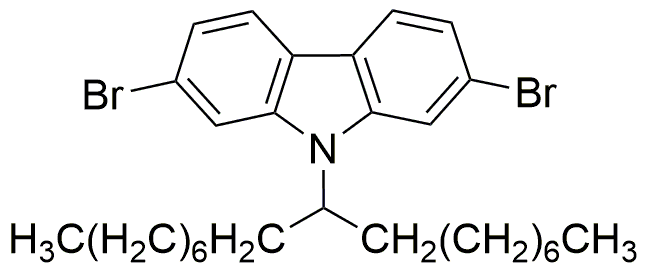2,7-Dibromo-9-(9-heptadecyl)carbazole is widely utilized in research focused on:
- Organic Electronics: This compound is used in the development of organic light-emitting diodes (OLEDs) and organic solar cells, providing enhanced efficiency and stability compared to traditional materials.
- Photovoltaic Applications: Its unique structure allows for improved light absorption and energy conversion in solar panels, making it a valuable component in renewable energy technologies.
- Fluorescent Dyes: The compound serves as a fluorescent marker in biological research, aiding in imaging and tracking cellular processes with high specificity and sensitivity.
- Polymer Additives: It is incorporated into polymers to enhance thermal stability and mechanical properties, which is beneficial in manufacturing durable materials for various industrial applications.
- Research in Photonics: The compound's properties make it suitable for applications in photonic devices, contributing to advancements in telecommunications and data transmission technologies.
Información general
Propiedades
Seguridad y normativas
Aplicaciones
2,7-Dibromo-9-(9-heptadecyl)carbazole is widely utilized in research focused on:
- Organic Electronics: This compound is used in the development of organic light-emitting diodes (OLEDs) and organic solar cells, providing enhanced efficiency and stability compared to traditional materials.
- Photovoltaic Applications: Its unique structure allows for improved light absorption and energy conversion in solar panels, making it a valuable component in renewable energy technologies.
- Fluorescent Dyes: The compound serves as a fluorescent marker in biological research, aiding in imaging and tracking cellular processes with high specificity and sensitivity.
- Polymer Additives: It is incorporated into polymers to enhance thermal stability and mechanical properties, which is beneficial in manufacturing durable materials for various industrial applications.
- Research in Photonics: The compound's properties make it suitable for applications in photonic devices, contributing to advancements in telecommunications and data transmission technologies.
Documentos
Hojas de datos de seguridad (HDS)
La SDS proporciona información de seguridad completa sobre la manipulación, el almacenamiento y la eliminación del producto.
Especificación del producto (PS)
La PS proporciona un desglose completo de las propiedades del producto, incluida la composición química, el estado físico, la pureza y los requisitos de almacenamiento. También detalla los rangos de calidad aceptables y las aplicaciones previstas del producto.
Certificados de análisis (COA)
Busque certificados de análisis (COA) ingresando el número de lote del producto. Los números de lote y de partida se pueden encontrar en la etiqueta de un producto después de las palabras "Lote" o "Lote".
Número de catálogo
Número de lote/lote
Certificados de origen (COO)
Este certificado de origen confirma el país en el que se fabricó el producto y también detalla los materiales y componentes utilizados en él y si se deriva de fuentes naturales, sintéticas u otras fuentes específicas. Este certificado puede ser necesario para cumplir con las normativas aduaneras, comerciales y regulatorias.
Número de catálogo
Número de lote/lote
Hojas de datos de seguridad (HDS)
La SDS proporciona información de seguridad completa sobre la manipulación, el almacenamiento y la eliminación del producto.
DownloadEspecificación del producto (PS)
La PS proporciona un desglose completo de las propiedades del producto, incluida la composición química, el estado físico, la pureza y los requisitos de almacenamiento. También detalla los rangos de calidad aceptables y las aplicaciones previstas del producto.
DownloadCertificados de análisis (COA)
Busque certificados de análisis (COA) ingresando el número de lote del producto. Los números de lote y de partida se pueden encontrar en la etiqueta de un producto después de las palabras "Lote" o "Lote".
Número de catálogo
Número de lote/lote
Certificados de origen (COO)
Este certificado de origen confirma el país en el que se fabricó el producto y también detalla los materiales y componentes utilizados en él y si se deriva de fuentes naturales, sintéticas u otras fuentes específicas. Este certificado puede ser necesario para cumplir con las normativas aduaneras, comerciales y regulatorias.

